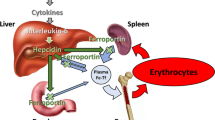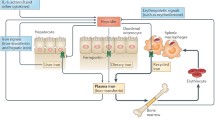Abstract
The role of iron in certain clinical infections is reviewed. In normal persons the antibacterial and antifungal properties of blood and other tissue fluids cannot be maintained unless there are exceptionally low levels of available iron. This is controlled by the presence of the unsaturated iron-binding proteins, transferrin and lactoferrin. In several clinical conditions an abnormal availability of iron is responsible for fatal septicaemia. This is because the phagocytic system is overwhelmed by rapidly growing organisms when iron is freely available.
Similar content being viewed by others
References
Griffiths E Iron in biological systems. In: Bullen JJ, Griffiths E (ed): Iron and infection. Molecular, physiological, and clinical aspects. J. Wiley, Chichester, 1987, p. 27–67.
Bullen JJ, Rogers HJ, Griffiths E Role of iron in bacterial infection. Current Topics in Microbiology and Immunology 1978, 80: 1–35.
Payne SM Iron and virulence in the familyEnterobacteriaceae. CRC Critical Reviews in Microbiology 1988, 16: 81–111.
Mickelson PA, Sparling PF Ability ofNeisseria gonorrhoeae, Neisseria meningitidis and commensalNeisseria species to obtain iron from transferrin and iron compounds. Infection and Immunity 1981, 33: 555–564.
Griffiths E Adaptation and multiplication of bacteria in host tissues. Philosophical Transactions of the Royal Society, Series B: Biological Sciences 1983, 303: 85–96.
Bullen JJ, Rogers HJ Bacterial iron metabolism and immunity toPasteurella septica andEscherichia coli. Nature 1969, 224: 380–382.
Bullen JJ, Cushnie GH, Rogers HJ The abolition of the protective effect ofClostridium welchii type A antiserum by ferric iron. Immunology 1967, 12: 303–312.
Rogers HJ Bacteriostatic effects of horse sera and serum fractions onClostridium welchii type A, and the abolition of bacteriostasis by iron salts. Immunology 1967, 12: 285–301.
Bullen JJ, Rogers HJ, Lewin JE The bacteriostatic effect of serum onPasteurella septica and its abolition by iron compounds. Immunology 1971, 20: 391–406.
Bullen JJ, Ward CG, Rogers HJ Iron, infection, and the role of bicarbonate. FEMS Microbiology Letters 1990, 7: 27–30.
Ward CG, Hammond JS, Bullen JJ Effect of iron on antibacterial function of human polymorphs and plasma. Infection and Immunity 1986, 51: 723–730.
Chart H, Griffiths E The availability of iron and the growth ofVibrio vulnificus in sera from patients with haemochromatosis. FEMS Microbiology Letters 1985, 26: 227–231.
Robins-Browne RM, Prpic JK Effects of iron and desferrioxamine on infections withYersinia enterocolitica. Infection and Immunity 1985, 47: 774–779.
Caroline L, Rosner F, Kozinn PJ Elevated serum iron, low unbound transferrin and candidiasis in acute leukaemia. Blood 1969, 34: 441–451.
Bullen JJ, Wilson AB, Cushnie GH, Rogers HJ The abolition of the protective effect ofPasteurella septica antiserum by iron compounds. Immunology 1968, 14: 889–898.
Bullen JJ The significance of iron in infection. Reviews of Infectious Diseases 1981, 3: 1127–1138.
Eaton JW, Brandt P, Mahoney JR, Lee JT Haptoglobin: a natural bacteriostat. Science 1982, 215: 691–692.
Fletcher J The effect of iron and transferrin on the killing ofEscherichia coli in fresh serum. Immunology 1971, 20: 493–500.
Bullen JJ, Ward CG, Wallis SN Virulence and the role of iron inPseudomonas aeruginosa infection in rabbits. Infection and Immunity 1974, 10: 443–450.
Bullen JJ, Wallis SN, Griffiths E The effect of anti-polymorphonuclear leukocyte serum onPseudomonas aeruginosa infection in rabbits. Immunology 1976, 30: 603–610.
Rogers PN, Wright IH, Ledingham IMA Critical abdominal sepsis. Journal of the Royal College of Surgeons of Edinburgh 1989, 34: 1–8.
Davis JH, Yull AB A toxic factor in abdominal injury. II: The role of the red cell component. Journal of Trauma 1964, 4: 84–89.
Bornside GH, Bouis PJ, Cohn I Hemoglobin andEscherichia coli, a lethal intraperitoneal combination. Journal of Bacteriology 1968, 95: 1567–1571.
Bullen JJ, Leigh LC, Rogers HJ The effect of iron compounds on the virulence ofEscherichia coli for guinea pigs. Immunology 1968, 15: 581–588.
Bornside GH, Bouis PJ, Cohn I Enhancement ofEscherichia coli infection and endotoxic activity by hemoglobin and ferric ammonium citrate. Surgery 1970, 68: 350–355.
Lee JT, Ahrenholz DH, Nelson RD, Simmons RL Mechanism of the adjuvant effect of hemoglobin in experimental peritonitis. V: The significance of the coordinated iron component. Surgery 1979, 86: 41–48.
Yull AB, Abrams JS, Davis JH The peritoneal fluid in strangulation obstruction. The role of the red blood cell andEscherichia coli bacteria in producing toxicity. Journal of Surgical Research 1962, 2: 223–232.
Pruett TL, Rotstein OD, Fiegel VD, Sorensen JJ, Nelson RD, Simmons RL Mechanism of the adjuvant effect of hemoglobin in experimental peritonitis. VIII: A leukotoxin is produced byEscherichia coli metabolism in hemoglobin. Surgery 1984, 96: 375–382.
Kluger MJ, Bullen JJ Clinical and physiological aspects. In: Bullen JJ, Griffiths E (ed): Iron and infection. Molecular, physiological, and clinical aspects. John Wiley, Chichester, 1987, p. 243–282.
Krizek TJ, Davis JH The role of the red cell in subcutaneous infection. Journal of Trauma 1965, 5: 85–94.
Kirkpatrick FH, Gordessky SE, Marinetti GV Differential solublization of proteins, phospholipids, and cholesterol of erythrocyte membranes by detergents. Biochimica et Biophysica Acta 1974, 345: 154–161.
Rogers HJ Bacterial iron transport as a target for antibacterial agents. In: Winkelmann G, van der Helm D, Neilands JB (ed): Iron transport in microbes, plants, and animals. VCH, Weinheim, 1987, p. 223–233.
Perry RD, Brubaker RP Accumulation of iron by yersiniae. Journal of Bacteriology 1979, 137: 1290–1298.
Brock JH, Ng J The effect of desferrioxamine on the growth ofStaphylococcus aureus, Yersinia enterocolitica andStreptococcus faecalis in human serum. Uptake of desferrioxamine-bound iron. FEMS Microbiology Letters 1983, 20: 439–442.
Marks MI, Pai CH, Lafleur L, Lackman L, Hammerberg O Yersinia enterocolitica gastroenteritis: a prospective study of clinical, bacteriologic, and epidemiologic features. Journal of Pediatrics 1980, 96: 26–31.
Lee LA, Gerber AR, Lonsway DR, Smith JD, Carter GP, Puhr ND, Parrish CM, Sikes RK, Finton RJ, Tauxe RV Yersinia enterocolitica 03 infection in infants and children associated with household preparation of chitterlings. New England Journal of Medicine 1990, 322: 984–987.
Rabson RA, Hallet AF, Koornhof HJ GeneralizedYersinia enterocolitica infection. Journal of Infectious Diseases 1975, 131: 447–451.
McLaren GD, Muir WA, Kellermeyer RW Iron overload disorders: natural history, pathogenesis, diagnosis and therapy. CRC Critical Reviews in Clinical Laboratory Sciences 1983, 19: 205–266.
Mofenson HC, Caraccio TR, Sharieff N Iron sepsis:Yersinia enterocolitica septicemia possibly caused by an iron overdose. New England Journal of Medicine 1987, 316: 1092–1093.
Melby K, Slordahl S, Gutterberg TJ, Nordbo SA Septicaemia due toYersinia enterocolitica after oral overdoses of iron. British Medical Journal 1982, 285: 467–468.
Robins-Browne RM, Prpic JK Desferrioxamine and systemicYersinosis. Lancet 1983, ii: 1372.
Hakim RM, Stivelman JC, Schulman G, Forsburg M, Wolfe L, Imber MJ, Lazarus JM Iron overload and mobilization in long term hemodialysis patients. American Journal of Kidney Diseases 1987, 10: 293–299.
Bouza E, Dominguez A, Meseguer M, Buzon L, Boixeda D, Revillo MJ, deRafael L, Martinez-Beltran J Yersinia enterocolitica septicemia. American Journal of Clinical Pathology 1980, 74: 404–409.
Kansouzidou A, Danielides VD Yersinia enterocolitica osteomyelitis in a child with β-thalassaemia. Clinical Microbiology Newsletters 1990, 12: 23–24.
Boelaert JR, van Landuyt HW, Valcke YJ, Cantinieaux B, Lornoy WF, Vanherweghem J, Moeillon P, Vandepitte JM The role of iron overload inYersinia enterocolitica andYersinia pseudotuberculosis bacteremia in hemodialysis patients. Journal of Infectious Diseases 1987, 156: 384–387.
Medical Research Council's Working Party on Leukaemia in Adults Treatment of acute myeloid leukaemia with daunorubicin, cytosine aribinoside, mercaptopurine, L-asparaginase, prednisone, and thioguanine: results of treatment of five multiple-drug schedules. British Journal of Haematology 1974, 27: 373–389.
Estey EH, Keating MJ, McCredy KB, Bodey GP, Freireich EJ Causes of initial remission induction failure in acute myelogenous leukaemia. Blood 1982, 60: 209–315.
Hunter RL, Bennett B, Towns M, Vogler WR Transferrin and disease. 1: Defects in the regulation of transferrin saturation with iron contribute to susceptibility to infection. American Journal of Clinical Pathology 1983, 84: 748–753.
Potaznik D, Groshen S, Miller D, Bagin R, Bhalla R, Schwartz M, de Sousa M Association of serum iron, serum transferrin saturation, and serum ferritin with survival in acute lymphocytic leukemia. American Journal of Pediatric Hematology/Oncology 1987, 9: 350–355.
Author information
Authors and Affiliations
Rights and permissions
About this article
Cite this article
Bullen, J.J., Ward, C.G. & Rogers, H.J. The critical role of iron in some clinical infections. Eur. J. Clin. Microbiol. Infect. Dis. 10, 613–617 (1991). https://doi.org/10.1007/BF01975810
Issue Date:
DOI: https://doi.org/10.1007/BF01975810




